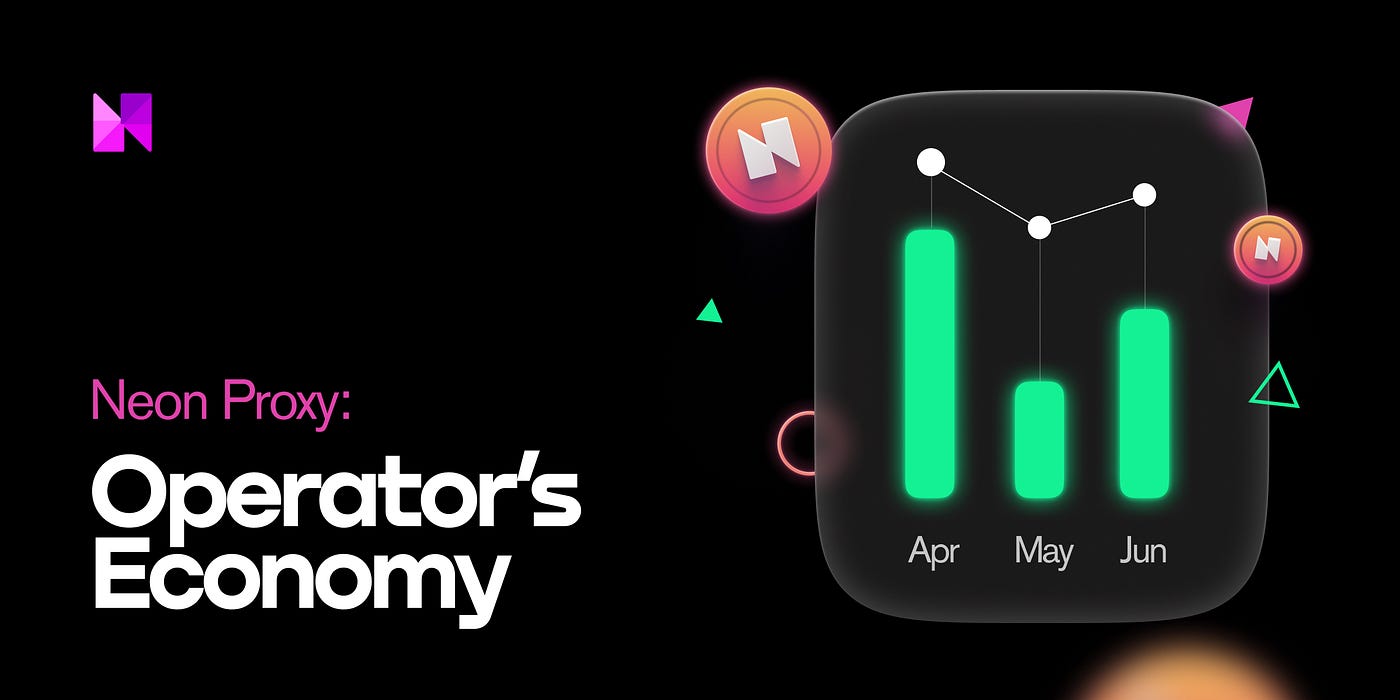
The Neon Proxy extends Solana’s many advantages to all existing Ethereum dApp users and developers without the need for programming conversion logic between blockchains. Instead, this work is delegated to Neon Proxy operators who facilitate the computational demands of the Neon EVM. Neon Proxy operators (we’ll refer to them as Proxy operators throughout the article) collectively host a network of servers that are responsible for packing and executing Ethereum transactions on Solana. With the Neon Proxy set to become one of the main entry points for users and dApps leveraging Solana, a robust and profitable network of operators is imperative for rapid settlement.
Neon 代理将 Solana 的许多优势扩展到目前所有以太坊 dApp 用户和开发人员,而无需在区块链之间编程转换逻辑。这项工作委托给 Neon 代理运营商,他们促进了 Neon EVM 的计算需求。 Neon 代理运营商(我们将在本文中将它们称为代理运营商)共同托管一个服务器网络,来负责在 Solana 上打包和执行以太坊交易。随着 Neon代理 将成为Solana用户和dApp 的主要入口之一,强大且盈利的运营商网络对于快速结算至关重要。
代理运营商的责任 (Responsibilities of Proxy Operators)
In order to become a Proxy operator, one must set up, configure, and maintain a server to accept Ethereum-like transactions and execute them on Solana. The steps operators take to package and execute Ethereum transactions on Solana is as follows:
为了成为代理操作员,必须设置、配置和维护一台服务器以接受类似以太坊的交易并在 Solana 上执行它们。运营商在Solana打包和执行以太坊交易的步骤如下:
-
Receive requests over Web3 API protocol.
通过 Web3 API 协议接收请求 -
Shape responses using Web3 API protocol.
使用 Web3 API 协议响应 -
Pack ETH tx into Solana tx.
将 ETH tx 打包到 Solana tx 中 -
Connect a proxy server to a Solana cluster RPC endpoint.
将代理服务器连接到 Solana 集群 RPC 端点 -
Successfully execute transactions.
成功执行交易
For more details, such as operator requirements and hardware recommendations, view the official documentation here.
有关更多详细信息,例如运营商要求和硬件建议,请查看官方文档 此处。
Neon运营商经济中的支付 (Payments in the Neon Operator’s Economy)
After a user submits a transaction to the Neon EVM, no additional steps are required to execute the instructions and store the data required for a transaction, as it will be done automatically by the operator’s software. The transaction type ultimately determines the cost of a transaction.
用户向 Neon EVM 提交交易后,不需要额外的步骤来执行指令和存储交易所需的数据,因为它将由运营商的软件自动完成。交易类型最终决定了交易的成本。
关键点 (Key Takeaways)
As depicted in the diagram above, Neon EVM program users pay in NEON for all consumed resources plus fees as decided by individual operators. Operators, however, use SOL to pay for the resources they consume. Specifically, operators pay Solana validator and governance fees in SOL. Operators pay the same amount for governance as Solana validators.
如上图所示,Neon EVM 用户使用 NEON 支付所有消耗的资源以及由各运营商决定的费用。然而,运营商使用 SOL 来支付他们消耗的资源。具体来说,运营商以 SOL 支付 Solana 验证者和治理费用。运营商支付与 Solana 验证者相同的治理费用。
Ultimately, operators pay for two types of resources: instructions for executing (“Execute ETH instructions”) and bytes for storing data on the blockchain (“Extend storage size”). Gas amount is estimated as the cost for all resources in a transaction in lamports (lamport = 10^-9 SOL).
最终,运营商为两种类型的资源付费:执行指令(“执行 ETH 指令”)和用于在区块链上存储数据的字节(“扩展存储大小”)。 Gas 量估计为 lamports 交易中所有资源的成本(lamport = 10^-9 SOL) 。
As outlined in our detailed Neon Proxy article, all inbound Neon transactions are automatically grouped into non-iterative or iterative transactions based primarily on their size.
正如我们详细的 Neon 代理文章 中所述,所有汇入的 Neon 交易都会主要基于它们的大小自动分组到非迭代或迭代交易。
Gas amount is calculated as follows:
Gas量计算如下
First, calculate gas for “Execute Eth Instructions”
- 2 * 5000 * iter_count (for an iterative transaction)
- 3 * 5000 (for a non-iterative transaction)
首先,为“Execute Eth Instructions”计算gas
- 2 * 5000 * iter_count (用于迭代交易)
- 3 * 5000(对于非迭代交易)
Then, add gas for “Extend Storage Size”
- Bytes * 6960
然后,为“Extend Storage Size”添加气体
- 字节 * 6960
Gas price = (1 + Operator fee) * SOL-to-NEON-rate
- Note: the operators fee is set by individual operators
Gas 价格 = (1 + Operator fee) * SOL-to-NEON-rate
- 注:运营商费用由个体运营商设定
Generally speaking, an operator’s net profit comes out to the difference between NEON Received minus SOL spent. This generalization, however, does not take into account hardware costs.
一般来说,运营商的净利润是收到的NEON 减去 SOL 花费的差额。然而,这种概括并没有考虑硬件成本。
As a general rule, an iterative transaction is typically more expensive than a non-iterative transaction because they require more resources for executing instructions.
作为一般规则,迭代交易通常比非迭代交易更昂贵,因为它们需要更多资源来执行指令。
These four fundamental transaction types Neon Operators process:
Neon Operators 处理的这四种基本交易类型:
- Contract deployment 合约部署
- Contract execution 合约执行
- Token transfer 代币转账
- Account creation 账户创建
We will post detailed explanations of all the steps and calculations involved in a Neon transaction in a future post to help illustrate the economics of different types of transactions.
我们将在以后的文章中详细解释 Neon 交易中涉及的所有步骤和计算,以帮助说明不同类型交易的经济学。
总结 (Wrapping It Up)
NEON tokens must be used for every transaction in Neon EVM. Users who verify and sign transactions via the Neon Proxy pay a one-time fee upfront, which is automatically distributed across the chosen proxy operator, Neon governance, and Solana validator. Individuals and/or companies who choose to configure and launch a Neon operator service will be exposed to the revenue associated with all inbound Ethereum transactions that leverage Neon EVM for faster and cheaper settlement. If this article leaves you with further questions, reach out to our team via Discord. We’ll be more than happy to help you understand how the Neon operator’s economy functions.
Neon EVM 中的每笔交易都必须使用 NEON 代币。通过 Neon 代理验证和签署交易的用户预先支付一次性费用,该费用将自动分配给所选的代理运营商、Neon 治理和 Solana 验证者。选择配置和启动 Neon 运营商服务的个人和/或公司,将获得与利用 Neon EVM 更快、更便宜的结算的所有汇入以太坊交易的相关收入。如果本文给您留下了其他问题,请通过 Discord 与我们的团队联系。我们非常乐意帮助您了解 Neon 运营商的经济运作方式。

